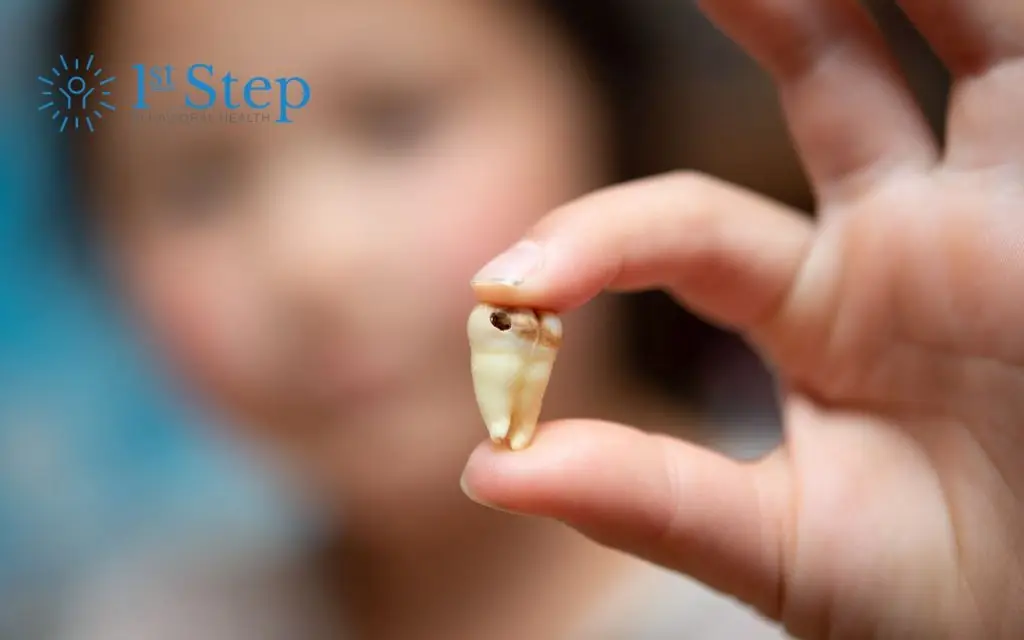Methamphetamine, also known as meth, is a dangerous and addictive stimulant drug. This illicit drug is becoming more popular in the United States. According to research from 2020, over 2.6 million people reported using methamphetamine.[1] Public health experts believe that this number has only grown since then.
People who become addicted to meth often face devastating mental and physical health consequences. Some face life-altering financial or legal trouble. Some lose jobs and relationships. The effects of methamphetamine abuse and addiction can be devastating.
One common effect of meth addiction is severe dental decay and damage. Some people refer to the dental problems caused by meth as “meth mouth.”
This article will explore what meth mouth is and how to treat it. You will learn:
- The risks and effects of methamphetamine
- The signs of meth mouth
- What causes meth mouth
- How to treat meth mouth
- Where to find comprehensive treatment and recovery support
If you or someone you love struggles with methamphetamine abuse or addiction, help is available at First Step Behavioral Health. Reach out to our intake team to learn about our treatment programs or schedule an intake appointment.
What is Meth?
Methamphetamine is a highly addictive stimulant drug. This illegal street drug looks like bluish-white rocks or powder.[2] Common street names for methamphetamine include:
- Crank
- Glass
- Ice
- Crystal Meth
Users smoke, snort, or inject meth. Some may also swallow it in pill form. After users ingest methamphetamine, the drug provides intense stimulant effects that may last for hours. Users may also experience a high or euphoric feeling while using meth. Some users report feeling superhuman or extremely powerful.
The process of creating methamphetamine is very dangerous. It involves combining and heating dangerous chemicals, including over-the-counter medications. However, using it is even more hazardous.
Methamphetamine abuse can have a permanent effect on a person’s mental and physical health. Using meth puts people at risk of overdose and other life-threatening medical complications.
What is Meth Mouth?
Meth mouth is the term people used to describe the severe damage this drug can do to meth users’ mouths. Some visible signs of meth mouth include:
- Missing teeth
- Receding gums
- Brown teeth
- Visible tooth decay
Meth mouth is so common that it has become one of the most unmistakable physical signs of meth abuse.
Research from the American Dental Association (ADA) revealed that meth mouth is extremely common. A research study from 2015 examined the dental records of 571 methamphetamine users.[3,4] The study revealed:
- 96% of participants had cavities
- 58% had untreated dental decay or damage
- 31% had six or more missing teeth
Certain risk factors increase the likelihood someone would develop meth mouth. Women, people over the age of 30, and smokers were more likely to have dental decay and gum disease. However, people who use meth more often we’re more likely to have the most severe dental damage.
What are the Causes of Meth Mouth?
Methamphetamine’s side effects are responsible for the damage to people’s dental health. There are several ways meth abuse can lead to meth mouth. Here is an overview of what may cause the symptoms of meth mouth.[3,4,5]
Periods of poor oral hygiene
Methamphetamine abuse can cause people’s lives to become chaotic. People who abuse methamphetamine are less likely to brush their teeth, floss, or receive regular dental care. This can lead to long-term dry mouth, tooth decay, and untreated gum disease.
Combination of drug-induced psychological and physiological effects
Methamphetamine abuse can lead to significant psychological and physiological effects. People may crave sweet sugary foods, suffer from insomnia, experience extreme nausea, and struggle with agitation or hyperactivity. These effects can prevent people from taking good care of their teeth and can lead to lifestyle changes that hurt dental health.
Tooth grinding and clenching
Methamphetamine is a stimulant drug that can cause people to become agitated or hyperactive. Users may clench or grind their teeth, which can damage enamel. Damage to the enamel makes teeth more vulnerable to staining, rotting, and decay.
Frequent vomiting
Methamphetamine abuse can cause frequent vomiting, which wears away at tooth enamel. People who abuse meth may be less likely to brush their teeth or receive regular dental visits to identify problems early. This can lead to untreated, long-term damage and decay.
Poor diet
Meth abuse can cause people to crave sugary drinks and food. Constant exposure to sugar and minimal dental hygiene can lead to significant dental problems, including decay and gum disease.
In many cases, the severe damage caused by meth abuse may be permanent. Intensive, invasive dental surgeries may be able to correct some damage. However, in many cases, people may lose teeth or have other permanent damage.
It is important to recognize the signs of meth abuse and addiction and seek treatment as soon as possible. This can help you avoid severe or permanent complications.
Find Treatment Now
If you or someone you love struggles with methamphetamine abuse or addiction, you are not alone. Comprehensive, compassionate treatment is available at First Step Behavioral Health. Contact our intake specialists to learn more about our programs or schedule an intake appointment.
References:
- National Institute on Drug Abuse (NIDA): What is the scope of methamphetamine use in the United States?
- NIDA: Methamphetamine
- American Dental Association (ADA): Methamphetamine
- ADA: How Methamphetamine Use Affects Dental Health
- National Institute of Health (NIH): Mechanisms underlying methamphetamine-related dental disease
Jump to a Section
Call (855) 425-4846
